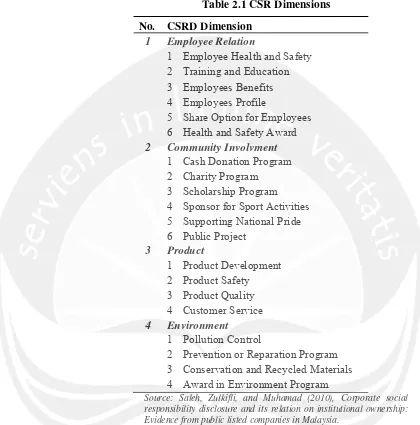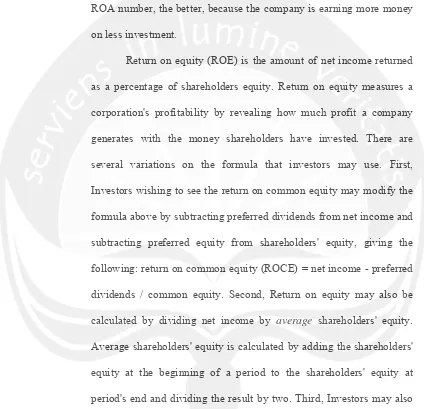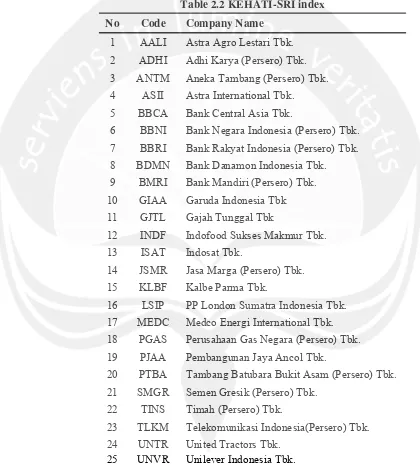Chapter II
Theoretical Background
A. Literature Review
Saleh, Zulkifli, and Muhamad (2010) study about CSRD and its relation toward IO in Malaysia, reveal that the involvement and disclosure of CSR activities are improving gradually, but the number of companies that participated on the analysis period did not improve significantly in accordance with stakeholders’ expectations. The research confirms the increasing of active involvement and promotion of CSR activities brings together the interests of stakeholders. The research also proved that a disclosure of CSR activities can also be used as leverage to attract institutional investors to actively invest in Malaysian PLCs that have solid platforms for socially responsible practices
social performance developed by Kinder, Lydenberg, Domini and Co., Inc (KDL) and they formed two models to measures the CSR for a sample of U.S. firms, found a significant positive relationship between the number of institutions owning shares and CSP.
Gardiner, Rubbens, and Bonfiglioni (2003) and Seifert, Morris, and Bartkus (2003) stated that the size of a business is an important variable in CSR, and acts as a barometer as to why a company engages in CSR activities. Gardiner, Rubbens, and Bogfiglioni (2003) conclude that CSR will only appear noticeably different if the CSR concept is fully integrated with the principles and practices of a company and when its progress is monitored regularly.
Cox, Brammer, and Millington (2004) investigated the pattern of institutional share holding in the UK and its relationship with socially responsible behaviour of companies. They found that social performance positively related with the long-run institutional investment. Their conclusion states that institutional investors will choose to place their investments in companies that have good social achievement and avoid investing in companies that have poor social performance.
institutional investors in Indonesia can not use as means to encourage CSP activities in Indonesian companies. Furthermore, the study would suggest that most institutional investors in Indonesia do not include CSP as part of their investment decisions.
Ziaul-Hoq, Saleh, Zubayer and Mahmud (2010) study about the effects of the CSRD on Institutional Ownership in Malaysia, the study use 200 largest companies which are taken out of 499 companies listed on the main board of Bursa Malaysia during period of 2000 to 2005. The results reveals that CSRD is positive significant related to institutional ownership and indicates that when the market is fairly efficient in the weak and semi strong forms. They concluded that investors utilized CSRD as sources of information in their investment decision making. Means that investigation on the relation of investment screens on the selection of stocks suggests that the long-term institutional investors’ choice through exclusion and avoiding those firms which have the worst social performance.
Purnomo and Widianingsih (2011) research about the influence of environmental performance and CSRD on financial performance, they use panel data of traded mining companies, chemical, pharmaceutical, cement, pulp, and paper companies listed on the Indonesia Stock exchange 2006-2011. The results indicate that environment performance has a positive effect on financial performance and CSRD is not able to strengthen the influence on financial performance.
investors did exist. An investor possibly achieving the same returns with fewer risks while the investors would take to consider both risk and return of investment similar to when they choose socially responsible companies. In this case high social responsibility done by companies could possibly reduces risk and provides the incentive for firm managers to invest their money in the positive CSR activities (Cox, Brammer, and Millington, 2004). From all those previous research about the relation of CSRD and IO, it can be concluded that most of the studies found positive significant relationships between CSR and institutional investors.
B. Theoretical Background
Based on the previous research there are terms used, such as Corporate Social Responsibility (CSR), Institutional Ownership (IO), control variables and KEHATI-SRI Index, the index used for the companies’ data used for the study. The term CSR also required the Dimension of CSR and the benefit of doing CSR.
1. Corporate Social Responsibility (CSR)
Indonesian researchers, Setiawan and Darmawan (2011) defined CSR is the actions in which the firms take into account their involvement in the social activities as well as mitigate the effects of their business on the community and natural environment. Their definition based on McWilliams and Siegel (2000) who defined CSR as the actions that appear to further some social good, beyond the interest of the firm and that which is required by law. CSR is a commitment to improve community well-being through discretionary business practices and contributions of corporate resources (K Kotler, P., and Lee, N. (2005) Corporate Social Responsibility, John Wiley
and Sons, Inc., Hoboken, New Jersey, page 3).
Table 2.1 CSR Dimensions No. CSRD Dimension
1 Employee Relation
1 Employee Health and Safety 2 Training and Education 3 Employees Benefits 4 Employees Profile
5 Share Option for Employees 6 Health and Safety Award 2 Community Involvment
1 Cash Donation Program 2 Charity Program
3 Scholarship Program 4 Sponsor for Sport Activities 5 Supporting National Pride
2 Prevention or Reparation Program 3 Conservation and Recycled Materials 4 Award in Environment Program
Source: Saleh, Zulkifli, and Muhamad (2010), Corporate social responsibility disclosure and its relation on institutional ownership: Evidence from public listed companies in Malaysia.
conducted by the firm can also lower the social risk and may benefit firms in the long run. Whether CSR might be an advantage or disadvantage for the firms may be depended on the effectively CSR applied by the firms and it can be concluded that CSR is the important instrument to support the company strategic to get the image that they want and the commercial goals.
2. Institutional Ownership (IO)
Institutional Ownership refers to a non-bank person or organization that trades securities in large enough share quantities or dollar amounts that they qualify for preferential treatment and lower commissions. Institutional investors face fewer protective regulations because it is assumed that they are more knowledgeable and better able to protect themselves. Some examples of institutional ownership are the ownership of a company's stock by mutual funds, pension funds, and other institutional investors, generally expressed as percentage of outstanding shares. A high proportion of institutional ownership may result in relatively large changes in a stock's price, as institutions tend to buy and sell the same stocks at the same time.
influence on organizational decisions, Shleifer and Vishny (1997) argued that institutional owners are influential in organizational decisions by exercising substantial voting power as well as having asymmetric information advantages over other shareholders (Schnatterly, Shaw and Jennings, 2008). Using their power and information, institutional investors tend to be more actively involved in firms’ decisions than non-institutional stockholders (Brickley, Leace and Smith, 1988). Moreover, because institutional owners often own significant percentages of the firm’s stock and cannot easily sell their shares, they are likely to be more attentive to the firm’s strategic decisions than other shareholders.
As a result, these institutional investors have a strong interest not only in the financial performance of the firm in which they invest in, but also in the strategies, activities, and other stakeholders of the firm (Fortune, 1993; Gilson and Kraakman, 1991; Holdderness and Sheena, 1988; Pound, 1992; Smith 1996; Johnson and Greening, 1999; and Mahoney and Robert, 2007). Since the firm’s long-term performance can be enhanced by good management practices, institutional holders are likely to be willing to support CSR-related actions.
banks, and securities firms offer credence services characterized by significant information asymmetry between the institutional investor and its clients. Investing in socially responsible businesses and maintaining the CSR ratings of the firms is one way for the institutional investor to signal to its potential clients that this institutional investor is reliable and responsible, and thereby to differentiate its services.
3. Control Variables
Control variables are a variable that remains unchanged or held constant to prevent its effects on the outcome and therefore may verify the behavior of and the relationship between independent and dependent variables. The previous research using several control variables, such as LSize, LSales, Beta, ATR, EPS, ROA, ROA, those variables use to mention about the other variables that will be affect the Institutional Investor on their investment decision. Considering the Indonesian economic condition and information disclose by the Indonesian PLCs, this study will use control variables such as LSales, ATR, EPS, ROA, ROE.
Asset turnover (ATR) measures a firm's efficiency at using its assets in generating sales or revenue - the higher the number the better. It also indicates pricing strategy: companies with low profit margins tend to have high asset turnover, while those with high profit margins have low asset turnover. Which also known as asset turnover ratio, a financial ratio that measures the efficiency of a company's use of its assets in generating sales revenue or sales income to the company. Asset turnover calculate from total revenue divided by total asset.
Earnings per share (EPS) is generally considered to be the single most important variable in determining a share's price. It is also a major component used to calculate the price-to-earnings valuation ratio. Earnings per share is found by taking the net income and dividing it by the basic or diluted number of shares outstanding, as reported on the companies’ annual report of financial report. An important aspect of EPS that's often ignored is the capital that is required to generate the earnings (net income) in the calculation. Two companies could generate the same EPS number, but one could do so with less equity (investment) - that company would be more efficient at using its capital to generate income and, all other things being equal, would be a "better" company.
ROA is displayed as a percentage. ROA for public companies can vary substantially and will be highly dependent on the industry. The ROA figure gives investors an idea of how effectively the company is converting the money it has to invest into net income. The higher the ROA number, the better, because the company is earning more money on less investment.
ending ROE. Calculating both beginning and ending ROEs allows an investor to determine the change in profitability over the period.
4. KEHATI-SRI index
As of June 8, 2009, in an effort to develop its programs, KEHATI has made a close relationship with business sector and in cooperation with the Indonesia Stock Exchange (BEI) has launched KEHATI SRI Index, following the standard and regulation of Sustainable and Responsible Investment (SRI). By launching KEHATI SRI Index, it was expected that the public would be made aware of the presence of an index showing which companies were regarded as beneficial and constantly managing sustainable development.
The objective of the index establishment is to materialize biodiversity conservation programs by raising awareness and consciousness toward biodiversity, among the public, business sector and capital market, and provide an open information to the public at large in identifying the selected companies rated by the index, which are considered to have various kinds of consideration in running their business in relation to environmental concern, business management, community involvement, human resources, human rights, their business behavior and way of operation with internationally accepted business ethics (http://www.kehati.or.id/en/indeks-sri-kehati-2.html).
guidance for investors. The presence of those companies will be evaluated twice a year, in April and October, and the result will be publicized by BEI, which can be followed through www.idx.co.id. The latest KEHATI SRI Index:
Table 2.2 KEHATI-SRI index
No Code Company Name
1 AALI Astra Agro Lestari Tbk. 2 ADHI Adhi Karya (Persero) Tbk. 3 ANTM Aneka Tambang (Persero) Tbk. 4 ASII Astra International Tbk.
5 BBCA Bank Central Asia Tbk.
6 BBNI Bank Negara Indonesia (Persero) Tbk. 7 BBRI Bank Rakyat Indonesia (Persero) Tbk. 8 BDMN Bank Danamon Indonesia Tbk. 9 BMRI Bank Mandiri (Persero) Tbk. 10 GIAA Garuda Indonesia Tbk 11 GJTL Gajah Tunggal Tbk
12 INDF Indofood Sukses Makmur Tbk. 13 ISAT Indosat Tbk.
14 JSMR Jasa Marga (Persero) Tbk. 15 KLBF Kalbe Parma Tbk.
16 LSIP PP London Sumatra Indonesia Tbk. 17 MEDC Medco Energi International Tbk. 18 PGAS Perusahaan Gas Negara (Persero) Tbk. 19 PJAA Pembangunan Jaya Ancol Tbk.
20 PTBA Tambang Batubara Bukit Asam (Persero) Tbk. 21 SMGR Semen Gresik (Persero) Tbk.
22 TINS Timah (Persero) Tbk.
23 TLKM Telekomunikasi Indonesia(Persero) Tbk. 24 UNTR United Tractors Tbk.
25 UNVR Unilever Indonesia Tbk.
C. Hypotheses Development
This study is try to find the evidence of CSR activities which are represented by CSRD in annual reports of Indonesian PLCs. Saleh, Zulkifli, and Mahmud (2007) stated that it can be explained by utilizing CSR for two reasons, first, it distinguish between the social and stakeholders issue. Second, the stakeholder theory is considered to be more appropriate to develop a testable hypothesis (Saleh, Zulkifli, and Mahmud, 2007).
It will be visible that most of other investors that were given the choice between two investment opportunities with identical risk-adjusted prospects, will more likely to invest in the companies that contribute to increasing the average CSR level (Boutin-Dufresne and Savaria, 2004). The empirical study conduct by Graves and Waddock (1994) shows that positive and significant relations exist between the social performance and shares held by institutional investors. Cox, Brammer, and Millington, (2004) found that social performance is positively related to long-term institutional investment. Mahoney and Roberts (2007) in their recent study also report that a significant relationship between companies’ composite social performance and the number of institutions investing in companies’ shares exist. Those previous research can be concluded that companies’ CSR activities are manifested in their CSRD and that such reporting of CSR is crucial to attract institutional investors, it can lead to the following hypothesis:
H1: There is positive impact of CSRD toward IO for the Public Listed


